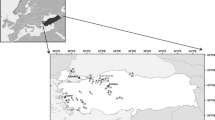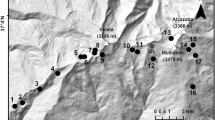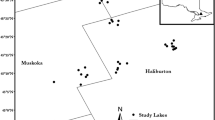Abstract
We examined the impact of lake trophic state on the taxonomic and functional structure of cladoceran communities and the role of nutrient loading in structuring both cladoceran and diatom communities. Surface sediment assemblages from 33 Irish lakes were analysed along a gradient of total phosphorus concentration (TP; 4.0–142.3 μg l−1), using a variety of statistical approaches including ordination, calibration and variance partitioning. Ordination showed that the taxonomic structure of the cladoceran community displayed the strongest response to changes in lake trophic state, among 17 measured environmental variables. Trophic state variables chlorophyll-a and TP explained about 20% of the variance in both cladoceran and diatom assemblages from a set of 31 lakes. Procrustes analysis also showed significant concordance in the structure of cladoceran and diatom communities (P < 0.001). Thus, lake trophic state affects the taxonomic structure of both primary and secondary producers in our study lakes. We also found a significant decrease in relative abundance of taxa associated with both macrophytes and sediments, or sediments only, along the TP gradient (r = −0.49, P = 0.006, n = 30), as well as an increase in the proportion of the planktonic group (r = 0.43, P = 0.017, n = 30). This suggests that cladoceran community structure may also be shaped by lake trophic state indirectly, by affecting habitat properties. We found no relationship between lake trophic state and the relative abundance of each of three cladoceran groups that display different body size. We compared community structure between bottom and top sediment samples in cores from six Irish lakes. Results revealed similar trajectories of nutrient enrichment over time, as well as a strong shift in cladoceran functional structure in most systems. This study confirms that Cladocera remains in lake sediments are reliable indicators of lake trophic state. This study also highlights the fact that taxonomic and functional structure should both be considered to account for the multiple factors that shape cladoceran communities.





Similar content being viewed by others
References
Alonso M (1996) Crustacea, Branchiopoda. Museo Nacional de Ciencias Naturales. CSIC, Madrid
Amsinck SL, Jeppesen E, Landkildehus F (2005) Relationships between environmental variables and zooplankton subfossils in the surface sediments of 36 shallow coastal brackish lakes with special emphasis on the role of fish. J Paleolimnol 33:39–51
Barnett AJ, Finlay K, Beisner BE (2007) Functional diversity of crustacean zooplankton communities: towards a trait-based classification. Freshw Biol 52:796–813
Battarbee RW, Jones VJ, Flower RJ, Cameron NG, Bennion H, Carvalho L, Juggins S (2001) Diatoms. In: Smol JP, Birks HJB, Last WM (eds) Tracking environmental change using lake sediments volume 3: terrestrial, algal, and siliceous indicators. Kluwer, Dordrecht, pp 155–202
Bennion H, Davidson TA, Simpson GL, Solovieva N, Rose N, Theophile S, Yang HD, Anderson NJ, Brooks SJ, Peglar S (2004a) Identification of reference lakes and evaluation of palaeoecological approaches to define reference conditions for UK (England, Wales, Scotland & North Ireland) ecotypes. SNIFFER, Edinburgh
Bennion H, Fluin J, Simpson GL (2004b) Assessing eutrophication and reference conditions for Scottish freshwater lochs using subfossil diatoms. J Appl Ecol 41:124–138
Birks HJB (1998) Numerical tools in quantitative paleolimnology—progress, potentialities and problems. J Paleolimnol 20:301–332
Bjerring R, Becares E, Declerck S, Gross EM, Hansson LA, Kairesalo T, Nykanen M, Halkiewicz A, Kornijow R, Conde-Porcuna JM (2009) Subfossil Cladocera in relation to contemporary environmental variables in 54 Pan-European lakes. Freshw Biol 54:2401–2417
Borcard D, Legendre P, Drapeau P (1992) Partialling out the spatial component of ecological variation. Ecology 73:1045–1055
Bossard M, Feranec J, Otahel J (2000) CORINE land cover technical guide: Addendum 2000. European Environment Agency, Copenhagen
Brodersen KP, Whiteside MC, Lindegaard C (1998) Reconstruction of trophic state in Danish lakes using subfossil chydorid (Cladocera) assemblages. Can J Fish Aquat Sci 55:1093–1103
Cameron NG (1995) The representation of diatom communities by fossil assemblages in a small acid lake. J Paleolimnol 14:185–223
Chen G, Dalton C, Leira M, Taylor D (2008) Diatom-based total phosphorus (TP) and pH transfer functions for the Irish Ecoregion. J Paleolimnol 40:143–163
Davidson TA, Sayer CD, Perrow MR, Bramm M, Jeppesen E (2007) Are the controls of species composition similar for contemporary and sub-fossil cladoceran assemblages? A study of 39 shallow lakes of contrasting trophic status. J Paleolimnol 38:117–134
de Eyto E, Irvine K (2001) The response of three chydorid species to temperature, pH and food. Hydrobiologia 459:165–172
de Eyto E, Irvine K (2002) The use of the family Chydoridae (Anomopoda, Branchiopoda) as indicators of lake ecological quality in Ireland. Biol Envi 102B:81–91
de Eyto E, Irvine K, Garcia-Criado F, Gyllstrom M, Jeppensen E, Kornijow R, Miracle MR, Nykanen M, Bareiss C, Cerbin S, Salujoe J, Franken R, Stephens D, Moss B (2003) The distribution of chydorids (Branchiopoda, Anomopoda) in European shallow lakes and its application to ecological quality monitoring. Arch Hydrobiol 156:181–202
DeNicola DM, de Eyto E, Wemaëre A, Irvine K (2004) Using epilithic algae communities to assess trophic status in Irish lakes. J Phycol 40:481–495
Dodson SI, Frey DG (2001) Cladocera and other branchiopoda. In: Thorp HJ, Covich AP (eds) Ecology and classification of North American freshwater invertebrates. Academic Press, London, pp 723–786
Duigan CA (1992) The ecology and distribution of the littoral freshwater Chydoridae (Branchiopoda, Anomopoda) of Ireland, with taxonomic comments on some species. Hydrobiologia 241:1–70
Duigan CA, Kovach WL (1994) Relationships between littoral microcrustacea and aquatic macrophyte communities on the Isle of Skye (Scotland), with implications for the conservation of standing waters. Aquat Conserv Mar Freshwat Ecosyst 4:307–331
European Commission (2000) Directive 2000/60/EC of the European Parliament and of the Council of 23 October 2000—Establishing a framework for community action in the field of water policy. Off J Eur Commun 1–72
Frey DG (1962) Supplement to the taxonomic and phylogenetic significance of the head pores of the Chydoridae (Cladocera). Int Rev Gesamten Hydrobiol 47:603–609
Frey DG (1986) Cladocera analysis. In: Berglund BE (ed) Handbook of holocene palaeoecology and palaeohydrology. Wiley, New York, pp 667–692
Goulden CE, Frey DG (1963) The occurrence and significance of lateral head pores in the genus Bosmina (Cladocera). Int Rev Gesamten Hydrobiol 48:513–522
Hall RI, Smol JP (1992) A weighted-averaging regression and calibration model for inferring total phosphorus concentration from diatoms in British Columbia (Canada) lakes. Freshw Biol 27:417–434
Heino J (2008) Patterns of functional biodiversity and function-environment relationships in lake littoral macroinvertebrates. Limnol Oceanogr 53:1446–1455
Hofmann W (1987) Cladocera in space and time: analysis of lake sediments. Hydrobiologia 145:315–321
Hofmann W (1996) Empirical relationships between cladoceran fauna and trophic state in thirteen northern German lakes: analysis of surficial sediments. Hydrobiologia 318:195–201
Irvine K, Allott N, de Eyto E, Free G, White J, Caroni R, Kennelly C, Keaney J, Lennon C, Kemp A, Barry E, Day S, Mills P, O’ Riain G, Quirke B, Twomey H, Sweeney P (2001) The ecological assessment of Irish lakes: the development of a new methodology suited to the needs of the EU directive for surface waters. Environmental Protection Agency, Wexford, Ireland
Jackson DA (1995) PROTEST: a PROcrustean randomization TEST of community environment concordance. Ecoscience 2:297–303
Jeppesen E, Madsen EA, Jensen JP, Anderson NJ (1996) Reconstructing the past density of planktivorous fish and trophic structure from sediment zooplankton fossils—a surface sediment calibration data set from shallow lakes. Freshw Biol 36:115–127
Jeppesen E, Jensen JP, Jensen C, Faafeng B, Hessen DO, Søndergaard M, Lauridsen T, Brettum P, Christoffersen K (2003) The impact of nutrient state and lake depth on top-down control in the pelagic zone of lakes: a study of 466 lakes from the temperate zone to the Arctic. Ecosystems 6:313–325
Jeziorski A, Yan ND, Paterson AM, DeSellas AM, Turner MA, Jeffries DS, Keller B, Weeber RC, McNicol DK, Palmer ME (2008) The widespread threat of calcium decline in fresh waters. Science 322:1374–1377
Juggins S (2003) C2 user guide-software for ecological and palaeoecological data analysis and visualisation. University of Newcastle, Newcastle upon Tyne
Korhola A, Rautio M (2001) Cladocera and other branchiopod crustaceans. In: Smol JP, Birks HJB, Last WM (eds) Tracking environmental change using lake sediments volume 3: zoological indicators. Kluwer, Dordrecht, pp 5–41
Korhola A, Olander H, Blom T (2000) Cladoceran and chironomid assemblages as qualitative indicators of water depth in subarctic Fennoscandian lakes. J Paleolimnol 24:43–54
Lampert W, Sommer U (2007) Limnoecology: the ecology of lakes and streams. Oxford University Press, Oxford
Legendre P, Legendre L (1998) Numerical ecology. Elsevier, Amsterdam
Leira M, Jordan P, Taylor D, Dalton C, Bennion H, Rose N, Irvine K (2006) Assessing the ecological status of candidate reference lakes in Ireland using palaeolimnology. J Appl Ecol 43:816–827
Lepistö L, Kauppila P, Rapala J, Pekkarinen M, Sammalkorpi I, Villa L (2006) Estimation of reference conditions for phytoplankton in a naturally eutrophic shallow lake. Hydrobiologia 568:55–66
Lepš J, Šmilauer P (2003) Multivariate analysis of ecological data using CANOCO. Cambridge University Press, Cambridge
Lotter AF, Birks HJB, Hofmann W, Marchetto A (1997) Modern diatom, cladocera, chironomid, and chrysophyte cyst assemblages as quantitative indicators for the reconstruction of past environmental conditions in the Alps. I. Climate. J Paleolimnol 18:395–420
Lotter AF, Birks HJB, Hofmann W, Marchetto A (1998) Modern diatom, cladocera, chironomid, and chrysophyte cyst assemblages as quantitative indicators for the reconstruction of past environmental conditions in the Alps. II. Nutrients. J Paleolimnol 19:443–463
Nilssen JP, Sandoy S (1990) Recent lake acidification and cladoceran dynamics: surface sediment and core analyses from lakes in Norway, Scotland and Sweden. Philos Trans R Soc London B 327:299–309
R Development Core Team (2006) R: a language and environment for statistical computing. R Foundation for Statistical Computing, Vienna, Austria
Sayer CD (2001) Problems with the application of diatom-total phosphorus transfer functions: examples from a shallow English lake. Freshw Biol 46:743–757
Scheffer M (1998) Ecology of shallow lakes. Kluwer, Dordrecht
Shumate BCA, Schelske CLA, Crisman TLA, Kenney WFA (2002) Response of the cladoceran community to trophic state change in Lake Apopka, Florida. J Paleolimnol 27:71–77
Taylor D, Dalton C, Leira M, Jordan P, Chen G, León-Vintró L, Irvine K, Bennion H, Nolan T (2006) Recent histories of six productive lakes in the Irish Ecoregion based on multiproxy palaeolimnological evidence. Hydrobiologia 571:237–259
ter Braak CJF (1987) Ordination. In: Jongman RHG, ter Braak CJF, van Tongeren OFR (eds) Data analysis in community and landscape ecology. Pudoc, Wageningen, pp 91–173
ter Braak CJF, Šmilauer P (2002) CANOCO reference manual and CanoDraw for Windows user’s guide: software for canonical community ordination (version 4.5). Microcomputer Power Ithaca, NY
Thoms MC, Ogden RW, Reid MA (1999) Establishing the condition of lowland floodplain rivers: a palaeo-ecological approach. Freshw Biol 41:407–423
Tibby J (2004) Development of a diatom-based model for inferring total phosphorus in south-eastern Australian water storages. J Paleolimnol 31:23–36
Tilman D, Kilham SS, Kilham P (1982) Phytoplankton community ecology: the role of limiting nutrients. Annu Rev Ecol Sys 13:349–372
Vermaire JC, Gregory-Eaves I (2008) Reconstructing changes in macrophyte cover in lakes across the northeastern United States based on sedimentary diatom assemblages. J Paleolimnol 39:477–490
Wemaëre A (2005) Influence of catchment characteristics on the relationship between land use and lake water quality in County Clare. Ph.D. Thesis, Trinity College, University of Dublin, Dublin
Whiteside MC (1970) Danish chydorid cladocera: modern ecology and core studies. Ecol Monogr 40:79–118
Acknowledgments
This work was funded by the Irish Environmental Protection Agency (project #2002-W-LS/7 and doctoral scholarship #2002_PHD2_34). We thank Ken Irvine and Elvira de Eyto for help with Cladocera analysis. Thanks are also due to Manel Leira, Phil Jordan, Catherine Duigan, Alice Wemaëre, Jim Bowman, Ruth Little and Helen Walsh.
Author information
Authors and Affiliations
Corresponding author
Rights and permissions
About this article
Cite this article
Chen, G., Dalton, C. & Taylor, D. Cladocera as indicators of trophic state in Irish lakes. J Paleolimnol 44, 465–481 (2010). https://doi.org/10.1007/s10933-010-9428-2
Received:
Accepted:
Published:
Issue Date:
DOI: https://doi.org/10.1007/s10933-010-9428-2




